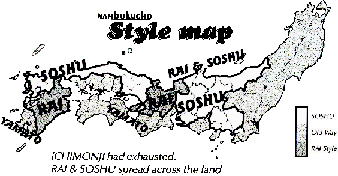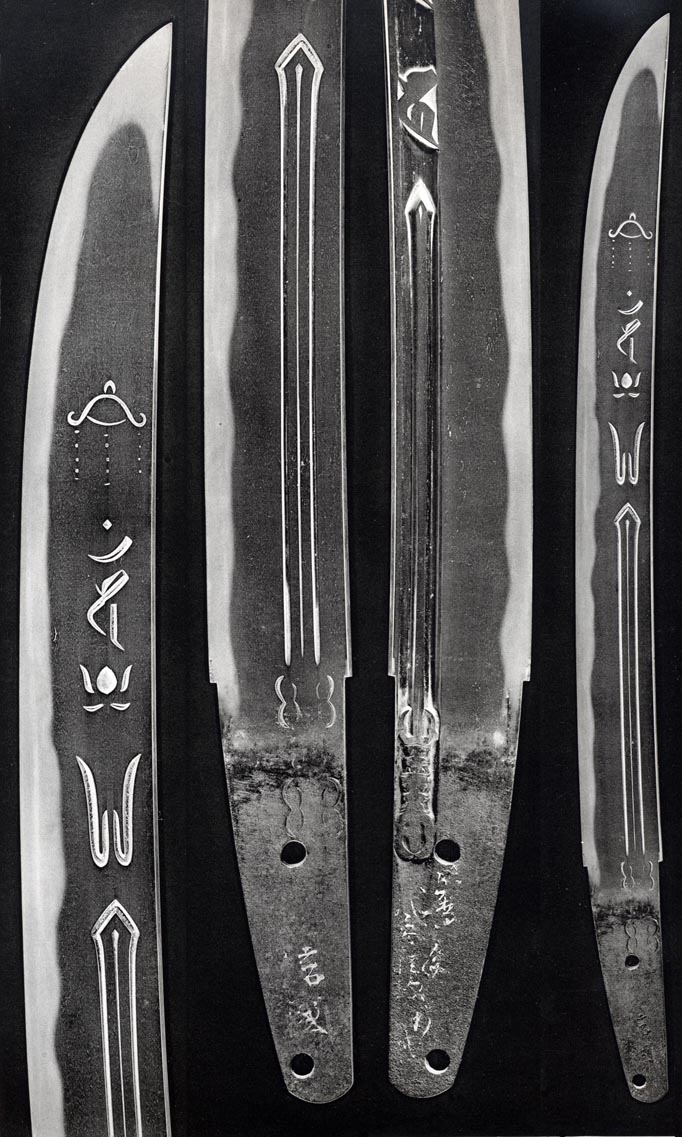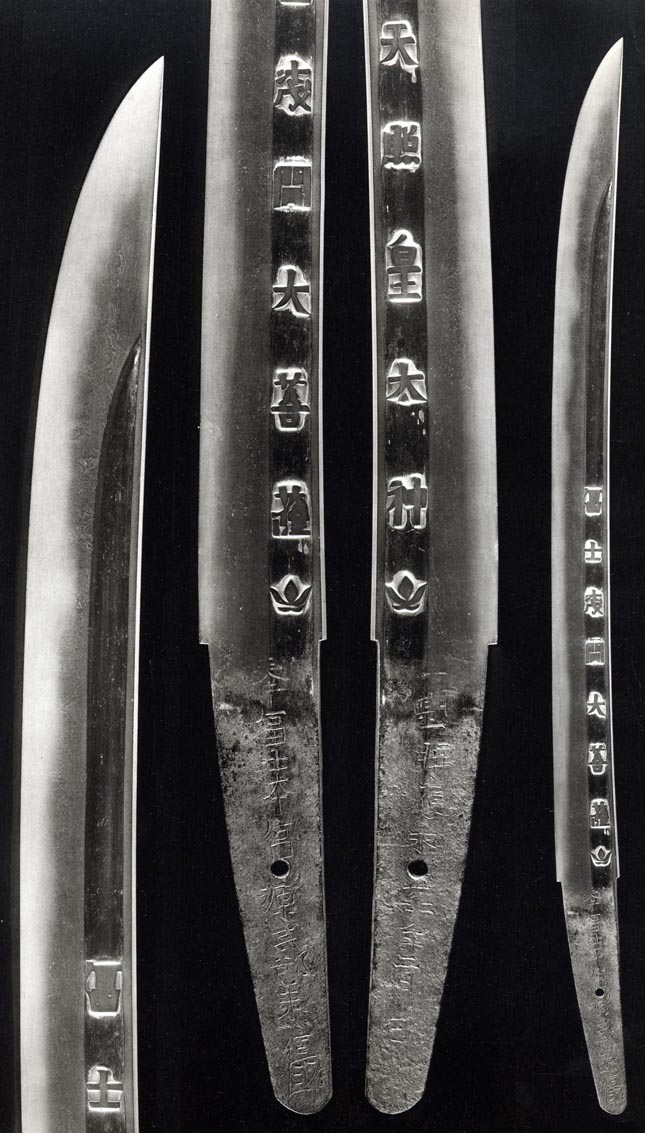|
|
|
|
 NOBUKUNI: KO-MOKUME or O-MOKUME with MASAME that shows _____________ RAI KUNITOSHI SHO-O 1288 - See Rai Kunitoshi __|___ RYOKAI EI-NIN 1293 - See Ryokai |___________________________________ __|_____ - brothers - ___|____ HISANOBU (RYOKAI 2) TOKU-JI 1306 KUNIHISA SHO-KEI 1331 __|____________________________________ NOBUHISA Changed name becoming NOBUKUNI(1) KEM-MU 1334 __|_____ NOBUKUNI(2) EN-BUN 1356 "Three Students" | SADAMUNE |___________________ ________ __________ _________________ __|_____ ___|____ ___|____ ____|____ ___________|____ NOBUKUNI(3) SADAKUNI MASANOBU SADATOSHI SANJO YOSHITSUGU | SHI-TOKU 1384 -TEI-JI 1362- O-AN 1368 MEI-TOKU 1390 |____________________________________ __|__________________ ____|____ NOBUMITSU (NOBUKUNI 4) O-EI 1394 SADAMITSU KO-O 1389 __|_________________ NOBUSADA (NOBUKUNI 5) O-EI 1394 to EI-KYO 1429 |___________________________ ______________________ __|_____ ___|____ ___|____ NOBUKUNI(6) KAN-SHO 1460 KIYOHISA BUN-AN 1444 SADAKUNI __|_____ _________ _________ EI-KYO 1429 NOBUKUNI BUN-MEI 1469 YOSHIHISA SADASHIGE __|_____ - EI-KYO 1429 - NOBUKUNI TEN-MON 1532 _________ ________ _________ _________ SHIGEKUNI SANEMUNE YOSHIKUMO YOSHIYASU TEN-MON 1532 - BUN-MEI 1469 - To BUZEN O-NIN 1467: YAMASHIRO Swordmaking Fades NOBUHISA KEM-MU: Became NOBUKUNI(1). A son of either HISANOBU or KUNIHISA. Inscribed pieces have fixed EN-KEI 1308 to HISANOBU which then testifies KEM-MU 1334 for NOBUHISA. An EN-BUN ZAI-MEI TANTO has set for him a work period ceiling of 1356 and also tilts theory in favor of HISANOBU, as father. NOBUKUNI(1) or NOBUHISA made swords in RYOKAI style, SUGUHA or active MIDARE as passed from RAI KUNITOSHI to RYOKAI to HISANOBU. His son, NOBUKUNI(2) is said to have been student to SOSHU SADAMUNE which evokes, therefore, the looked for SOSHU style as definer. RYOKAI style for NOBUKUNI(1) is KO-ITAME with JI-NIE. Defined SUGUHA with ASHI or small CHOJI-like patterns emerging from MIDARE BA. |
|
|
|
"The Three Students" of SOSHU SADAMUNE
NOBUKUNI(2) EN-BUN (f: NOBUHISA, grf: HISANOBU): SHINANO-no-KOJI JU at GOJO BOMON. Particularly noted for the quality and "health" of his steel, he endowed his name and school with SOSHU style and is often referred as NOBUKUNI(1). The 2nd NOBUKUNI will show the wide, thin SOSHU DAMBIRA NAMBOKUCHO SUGATA typical of EN-BUN 1356 to TEI-JI 1362. The work of NOBUKUNI is very close to that of his teacher, SADAMUNE and is often confused. NOBUKUNI pursued the SADAMUNE CHIKEI and might show an even greater profusion. SADAMUNEs' SUNAGASHI will seem to pull from the surfaces of form, following the line of HAMON. NOBUKUNI SUNAGASHI is similar but will also tend to run through forms, lazily paralleling the HA. CHIKEI twists in standing O-MOKUME HADA with MASAME under a JI-NIE veil. YAKIBA: KO-NIE pattern where undulating NOTARE holds an ordered, KAKU-like KO-GUNOME MIDARE defined of straight falling ASHI. SHIMA-BA dots the air. Swept SUNAGASHI brushes HAKIKAKE to the BOSHI. Deep KAERI. Famous for the highest skill of HORIMONO. Resembles SHINTOGO student, SAGAMI DAISHINBO. His two-character MEI is found below the ANA. The sometimes left-tilted NOBU is small and boxy. The KUNI pole falls from left of center to right of center. Note: MU-MEI NAKAGO are differentiated from SADAMUNEs' swept SOSHU style, often mildly pointed KENGYO-like JIRI, by the NOBUKUNI rounded KURIJIRI NAKAGO. Tokubetsu Juyo Nobukuni |
Nobukuni Dambira - Juyo
Bunkazai Nobukuni Dambira Nagasa: 1 Shaku 2 Bu 6 Rin (38.1cm) Sori: 2 Bu (0.61cm) Moto-haba: 1 Sun 1 Bu (3.48cm) Moto-kasane: 2 Bu 2 Rin (0.67cm) Nakago: 3 Sun 5 Bu (10.76cm) Hira-tsukuri, Mitsu-mune, wide Mihaba and even curve. Tengai Priest's Hood, Bonji, Rendai with Kuwagata "Helmet Antlers" and SuKen. Ura: Bo-Hi frames carved Bonji, Vajra and Ken. Tightly knit Itame Hada has Ji-Nie and Chikei. Undulations hold Ko-Gunome Ko-Midare Ba in Ko-Nie, deep Nioi and strafing, Nobukuni-style Sunagashi which pulls Niju in mid. O-Maru Boshi with Hakikake. O-Suriage Mumei, Kurijiri Nakago has two Mekugi-ana and Shu-Mei lacquer attribution. |
This piece was passed as a presentation among the 9th and 10th TOKUGAWA SHOGUNs. The long, thin-bodied
HIRA-TSUKURI NAMBOKU DAMBIRA has grooves that
convey the notion of SHINOGIs. His SOSHU teachers are famous for a swirling O-MOKUME that is passed to this blade. JI-NIE wets as CHIKEI twists. Rising GUNOME corrupts NOTARE waves where lazy SUNAGASHI straps falling ASHI. KINSUJI plies under dotting SHIMA-BA. Falling NIOI-ASHI sneaks to the HA. KINSUJI and SUNAGASHI clasp across a broom-swept Hakikake KO-MARU. The deep-falling KAERI disappears to the MUNE. Past mountings competed for
the same ANA on the otherwise UBU NAKAGO.
|
YAMASHIRO NOBUKUNI School
|
|
|
NOBUSADA (NOBUKUNI 5) O-EI (f: NOBUKUNI 3): SHIKIBUnoJO. Possibly the son of the 4th NOBUKUNI. NOBUSADA changed his name to NOBUKUNI in O-EI. A NOBUSADA signature is seen in KO-EI 1342. As NOBUKUNI(5) worked the O-EI up to his death in EI-KYO, SHIKIBUJO and KO-EI NOBUSADA are thought to be different men. Again, his work period of some 30 years to EI-KYO would set his relationship to SAEMONnoJO NOBUKUNI(4) (aka: NOBUMITSU), whose early MEI starts in SHI-TOKU 1384, as the likely parent. MOKUME with MASAME shows CHIKEI and JI-NIE in the style of the 4th. As with the 4th, there are CHOJI, GUNOME with TOBI and YUBASHIRI-flared MIMIGATA and YAHAZU forms. Remember, with NOBUKUNI: YUBASHIRI rings O-EI bells. A repeating TOGARI in the theme should focus one's attention on NOBUKUNI(5). NOBUKUNI(6) KAN-SHO: SABUROZAEMON. From BUN-AN 1444 to BUN-SHO 1466. The O-NIN War crushes the city and arts of KYOTO. The great YAMASHIRO KOTO sword tradition permanently wanes. Standing ITAME without variation. YAKIBA is generally KO-NIE GUNOME-MIDARE HA. NOBUKUNI follows in BUN-MEI 1469 and TEN-MON 1532. |
Shikibu-no-Jo
Nobukuni - Bunkazai Shikibu-no-jo Nobukuni Nagasa: 1 Shaku 4 Bu 4 Rin (43.6cm) Sori: 3 Bu (0.91cm) Moto-haba: 1 Sun 5 Rin (3.18cm) Moto-kasane: 2 Bu 6 Rin (0.79cm) Nakago: 4 Sun 5 Rin (12.27cm) Hira-tsukuri, Mitsu-mune, wide bladed. Wide Bo-Hi provides the frame for the standing carved Kanji. Ko-Itame in standing Hada has dappled Ji-Nie across the surface. Midare and Gunome are mixed in an undulating line of deep Nioi-Fukashi and Ara-Nie. Kinsuji strikes within while Tobi-yaki dots above. Midare-Komi Boshi is Hakikake at the turn. Ubu, one Mekugi-ana. Straight fall to Kurijiri. Signed: Ho Fuji-Hongu Minamoto Shikibu-no-Jo Nobukuni Ikki Ichikoshi O-ei Sanju Yonen N-Gatsu Hi - 1427 Hori: Fuji Sengen DaiBosatsu Ise Amaterasu KoTaigin |
SADAKUNI TEI-JI: GENGORO. Moved to ECHIGO to study under YAMAMURA MASANOBU. Changed his name to NOBUKUNI in EI-TOKU 1381. Buddhist name: RYOICHI. Made TACHI and TANTO. MOKUME with MASAME. SUGUHA and KO-MIDARE BA. GENGORO said to have signed his KUNI with a sword (TO) under a roof (YANE), enclosed in a frame. MASANOBU TEI-JI (t: NOBUKUNI): Summoned to ECHIGO by the Lord of YAMAMURA. Changed his name in later years to NOBUKUNI. Made HIRA-TSUKURI TANTO of normal width. Running ITAME HADA has JI-NIE. Dark steel. KO-NIE SUGUHA or ARA-NIE on GUNOME-MIDARE of defined NIOI. YOSHITSUGU(1) MEI-TOKU (t: NOBUKUNI, f: YOSHIHIRO): SANJO JU. His work period begins in O-AN 1368. HEIANJO smith of the late SANJO YOSHINORI line working near the KURAMA-DERA Temple in KYOTO. KO-MIDARE BA with ASHI. See HEIANJO - from YOSHINORI and KURAMA SEKI. YOSHITSUGU(2) EI-KYO: HEIANJO. SANJO JU. See HEIANJO YOSHINORI. YOSHITSUGU(3) MEI-O: See KURAMA SEKI. |
|